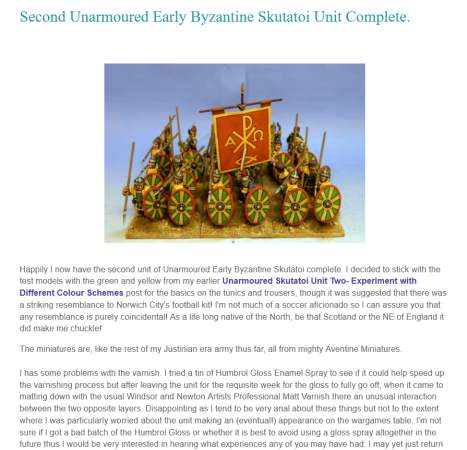First of all, a disclaimer. I paint, and take photos, for Warlord Games. I don't get paid - I get given enough castings for my own armies, and a deadline by which to get the painting and photography done. Other than that, I am my own boss, and do what I like.
There has been a fair amount of interest shown in The Dip recently, not least because of the high profile of industry newcomers The Army Painter and their friends at Warlord Games. Reactions to The Dip vary wildly - some love it, some don't seem to care, and some are vehement in their disapproval. I'll nail my colours to the mast here: I have become a big fan of The Dip - providing it's used carefully, and followed by a decent matt varnish. It wasn't always so - even a year ago, I was saying very rude things about The Dip and those who used it. But having been persuaded to try it, during a period when I was struggling to paint anything at all, I found that it answered my need at the time, and I have grown to love it.
The results it gives aren't up there with the works of Tom Weiss, Dave Woodward, Steve Dean, Kevin Dallimore, etc. But then, merely reasonably competent painter that I am, neither were my usual efforts. And I do believe that, with a modicum of care, the results are better than the vast majority of 'wargames standard' paintjobs, as well as being a lot faster. If I keep going at my current rate of production, I will have painted two 2,500-point WAB armies in about nine months - one Early Imperial Roman and one Ancient British.
I usually use Army Painter's Strong Tone Quick Shade. It isn't cheap, at £18.00 GBP per 250 ml tin, but a tin goes a very long way. The three different versions they produce are all used in the same way, but the amount and colour of the shading varies. Soft Tone gives a pale brown shadow; Strong Tone, a deeper brown shadow; Dark Tone, a black shadow. The brown shadow given by Strong Tone doesn't suit all basecoats equally well - it looks best applied over browns, fawns, reds, yellows, and olive greens. It's at its least realistic over strong or very light blues. Keeping those caveats in mind, though, the effect it gives can be very pleasing - shadows are infinitely well-blended, and - particularly compared to the 'standard' 3-colour basecoat, mid-tone, highlight system - seem very 'organic'. It will not shade colours deeper than itself - for those, you need to employ different methods.
A fair amount of rubbish has been typed about my efforts with The Dip, so this Workbench article is as much about setting the record straight as anything else. One or two people have suggested that I must do a lot of shading and highlighting before applying The Dip - I couldn't possibly get such good results otherwise. So let me assure you that, other than on really dark colours (like black) or large flat areas with no detail for The Dip to settle into, I just use a single base colour - no shading, and no highlighting before applying The Dip. Dark colours usually get one or two highlights before applying The Dip.
Originally, I agreed with ![]() Editor in Chief Bill
Editor in Chief Bill ![]()
![]() that I'd paint an Ancient British warrior, and finish up by showing him alongside a warband of his peers. But then, just as I was about to start, a small white Jiffy-bag dropped through the letterbox onto my doormat. Inside was the soon-to-be-released Boudica/Boudicca/Boadicea model from Warlord. What an ideal opportunity to show off The Dip on not only a figure wearing chainmail (Boudica), but one with a naked torso (her 'Victorian Strongman' bodyguard), a pair of horses and a chariot! These are the contents of said package:
that I'd paint an Ancient British warrior, and finish up by showing him alongside a warband of his peers. But then, just as I was about to start, a small white Jiffy-bag dropped through the letterbox onto my doormat. Inside was the soon-to-be-released Boudica/Boudicca/Boadicea model from Warlord. What an ideal opportunity to show off The Dip on not only a figure wearing chainmail (Boudica), but one with a naked torso (her 'Victorian Strongman' bodyguard), a pair of horses and a chariot! These are the contents of said package:







